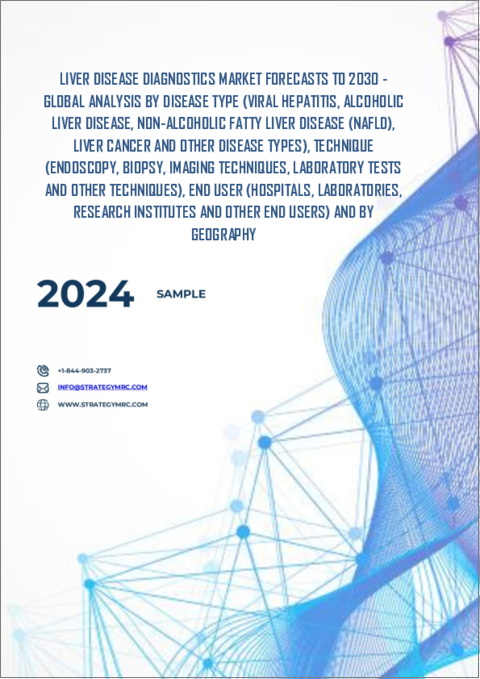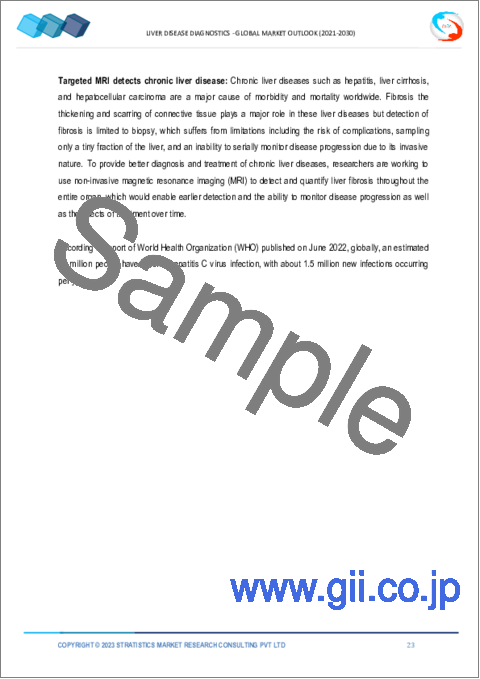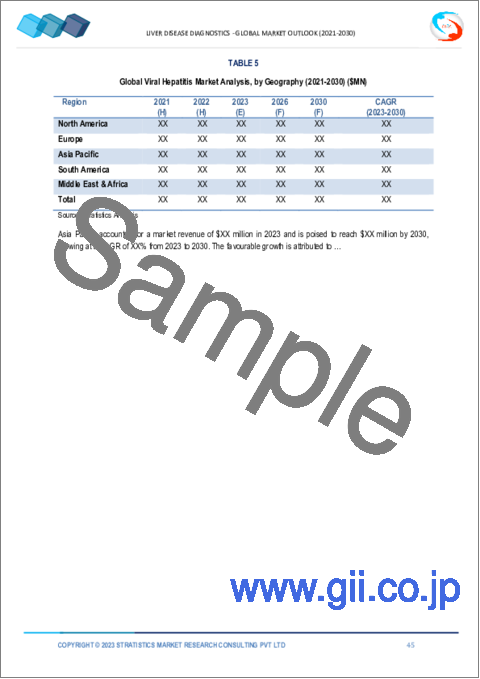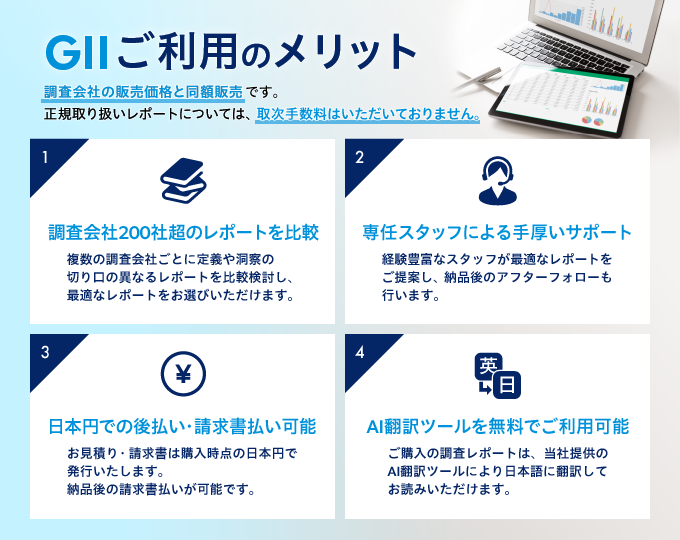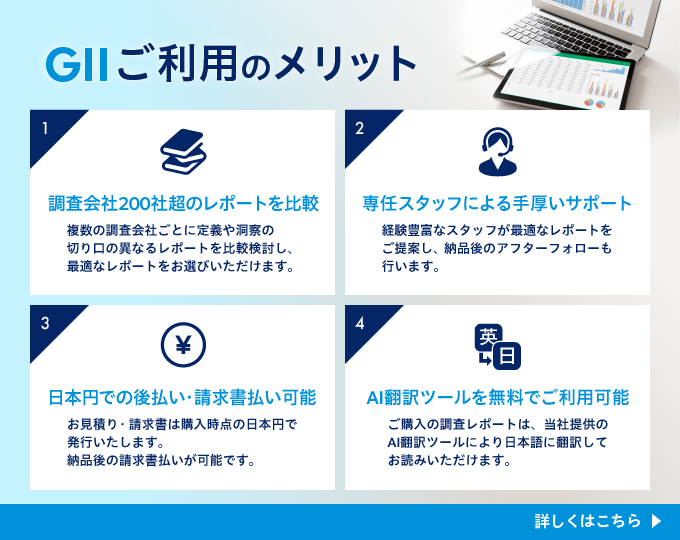|
|
市場調査レポート
商品コード
1403526
肝疾患診断市場の2030年までの予測: 疾患タイプ別、技術別、エンドユーザー別、地域別の世界分析Liver Disease Diagnostics Market Forecasts to 2030 - Global Analysis By Disease Type (Viral Hepatitis, Alcoholic Liver Disease, Non-alcoholic Fatty Liver Disease, Liver Cancer and Other Disease Types), Technique, End User and by Geography |
||||||
カスタマイズ可能
|
|||||||
| 肝疾患診断市場の2030年までの予測: 疾患タイプ別、技術別、エンドユーザー別、地域別の世界分析 |
|
出版日: 2024年01月01日
発行: Stratistics Market Research Consulting
ページ情報: 英文 200+ Pages
納期: 2~3営業日
|
全表示
- 概要
- 図表
- 目次
Stratistics MRCによると、肝疾患診断の世界市場は2023年に403億2,000万米ドルを占め、予測期間中にCAGR 8.1%で成長し、2030年には695億4,000万米ドルに達すると予測されています。
肝疾患の診断薬は、肝臓に関連するさまざまな疾患の判定と治療に不可欠です。これらの診断には、肝臓の健康状態を評価し、異常を特定し、肝疾患の根本的な原因を特定するために考案された様々な処置や画像診断法が含まれます。さらに、アラニントランスアミナーゼ(ALT)やアスパラギン酸トランスアミナーゼ(AST)などの肝酵素値を測定する血液検査や、特定の抗体やウイルスマーカーの存在を評価する検査も、一般的に用いられる診断手段です。
2022年6月に発表された世界保健機関(WHO)の報告によると、世界全体で推定5,800万人がC型慢性肝炎ウイルスに感染しており、年間約150万人が新たに感染しています。
高まる意識と検診への取り組み
肝疾患診断は、非営利団体やヘルスケア団体のキャンペーンにより、肝疾患の深刻さに対する一般市民の意識が高まっているため、高い需要があります。さらに、薬物乱用の既往歴のある人や、肝疾患にかかりやすい特定の属性を持つ人など、一般的にリスクの高い人々を対象とした積極的な検診プログラムの結果、早期診断が増加しています。ヘルスケアシステムへの負担を軽減するだけでなく、予防医療への注目と意識の高まりは、定期的な検診を通じて肝臓の健康を管理する力を人々に与えています。
高度な診断にかかる法外な費用
大きな障壁は、高度な画像診断法や分子検査を含む最先端の肝臓病診断にかかる費用です。総費用は、高額な初期投資、継続的な維持費、専門的なトレーニングの必要性によって左右されます。さらに、このような経済的な障害があるため、これらの診断法が広く使用され、患者やヘルスケア機関が同様に利用できるようになることを妨げています。
オーダーメイド医療の発展
個別化医療の変化により、肝疾患診断市場には大きなチャンスがあります。肝疾患の診断と治療は、患者の遺伝子構成、ライフスタイルの選択、疾患特有の特徴に基づいて診断戦略をカスタマイズすることで、より正確なものとなります。さらに、ターゲットを絞った診断ツールの作成は、ゲノミクスと分子プロファイリングの発展によって可能になり、より効率的でカスタマイズされた患者ケアへの扉が開かれます。
コンプライアンスと規制上の問題
肝疾患診断市場は、より厳しくダイナミックな規制環境の脅威にさらされています。企業は、コンプライアンス要件に従わなければならず、必要な承認を確保し、複雑な規制プロセスを通過しなければならないため、時間やリソースの面で困難に直面し、製品上市が遅れる可能性もあります。しかし、市場参入企業にとっては、コンプライアンス違反は、法的問題、市場撤退、規制などの深刻なリスクとなります。
COVID-19の影響:
肝疾患診断市場は、COVID-19の大流行によって大きな影響を受けています。パンデミックによる世界の混乱は、閉鎖、ヘルスケアシステムの過度な負担、ウイルス対策へのリソースの振り向けなどを含み、一時的に、選択的な手術や定期的な受診の数を減らし、診断サービス全体の需要に影響を与えました。さらに、市場参入企業は、研究開発プロジェクトの遅延、サプライチェーンの中断、ヘルスケアの優先順位の変化による困難に直面しました。パンデミックは、強力な診断能力の重要性を浮き彫りにすることで、遠隔医療や遠隔モニタリングソリューションの採用を加速させました。
予測期間中、非アルコール性脂肪肝疾患(NAFLD)分野が最大となる見込み
非アルコール性脂肪性肝疾患(NAFLD)分野が最大のシェアを占めると予測されています。肥満とメタボリックシンドロームが一般的になっているため、非アルコール性脂肪性肝疾患(NAFLD)は慢性肝疾患の世界の主要原因として浮上しています。さらに、軽度の肝脂肪症から非アルコール性脂肪性肝炎(NASH)のような重篤な疾患まで様々なNAFLDの有病率の上昇が、このセグメントの優位性を牽引しています。このため、NAFLDの正確な診断と病期分類のための最先端の画像診断法や血液検査など、肝疾患診断のニーズが顕著に増加しています。
予測期間中にCAGRが最も高くなると予想されるのは調査機関セグメント
予測期間中に最もCAGRが高いセグメントは研究機関です。研究機関は、診断機器や手順の開発における技術革新と技術進歩の促進に不可欠です。このセグメントの堅調な成長は、トランスレーショナルリサーチ、バイオマーカー探索、革新的診断技術の開発に重点が置かれるようになってきたことに起因しています。さらに、研究機関は臨床研究を実施し、診断アッセイを検証し、診断企業や医療提供者と連携して新規診断技術の開発を主導しています。政府からの助成金や資金提供は、研究活動の活発化とともに研究機関セクターを前進させています。
最大のシェアを占める地域
北米が最大の市場シェアを占めると予想されます。技術革新を奨励する強力な規制環境、高いヘルスケア支出、技術進歩、確立されたヘルスケアインフラが、この地域が優位を占める理由の一部です。さらに、北米は重要な市場プレーヤーや研究機関の存在、先進的な診断技術の導入に向けた積極的なアプローチもあり、肝疾患診断市場で優位な地位を占めています。
CAGRが最も高い地域:
ヘルスケア診断薬市場は、アジア太平洋地域で最も高いCAGRでの成長が見込まれます。同地域の人口拡大、慢性疾患の頻度上昇、疾患の早期発見に対する一般市民の意識の高まり、ヘルスケアインフラへの多額の投資などがその要因です。急速な成長は、中間層の人口拡大、医療へのアクセスを向上させるための政府の取り組み、中国やヘルスケアなどの国々における技術の進歩が主な要因となっています。さらに、アジア太平洋地域は、そのダイナミックな性質と最先端の診断ソリューションの導入に重点を置いていることから、ヘルスケア診断業界において力強い成長を遂げることができる好位置にあります。
無料カスタマイズサービス
本レポートをご購読のお客様には、以下の無料カスタマイズオプションのいずれかをご利用いただけます:
- 企業プロファイル
- 追加市場プレイヤーの包括的プロファイリング(3社まで)
- 主要企業のSWOT分析(3社まで)
- 地域セグメンテーション
- 顧客の関心に応じた主要国の市場推計・予測・CAGR(注:フィージビリティチェックによる)
- 競合ベンチマーキング
- 製品ポートフォリオ、地理的プレゼンス、戦略的提携に基づく主要企業のベンチマーキング
目次
第1章 エグゼクティブサマリー
第2章 序文
- 概要
- ステークホルダー
- 調査範囲
- 調査手法
- データマイニング
- データ分析
- データ検証
- 調査アプローチ
- 調査ソース
- 1次調査ソース
- 2次調査ソース
- 前提条件
第3章 市場動向分析
- 促進要因
- 抑制要因
- 機会
- 脅威
- エンドユーザー分析
- 新興市場
- 新型コロナウイルス感染症(COVID-19)の影響
第4章 ポーターのファイブフォース分析
- 供給企業の交渉力
- 買い手の交渉力
- 代替品の脅威
- 新規参入業者の脅威
- 競争企業間の敵対関係
第5章 世界の肝疾患診断市場:疾患の種類別
- ウイルス性肝炎
- アルコール性肝疾患
- 非アルコール性脂肪肝疾患(NAFLD)
- 肝臓がん
- 他の種類の病気
第6章 世界の肝疾患診断市場:技術別
- 内視鏡検査
- 生検
- イメージング技術
- 超音波
- MRI
- CTスキャン
- 臨床検査
- 血液検査
- 肝機能検査
- 遺伝子検査
- その他の技術
第7章 世界の肝疾患診断市場:エンドユーザー別
- 病院
- ラボ
- 研究機関
- その他のエンドユーザー
第8章 世界の肝疾患診断市場:地域別
- 北米
- 米国
- カナダ
- メキシコ
- 欧州
- ドイツ
- 英国
- イタリア
- フランス
- スペイン
- その他欧州
- アジア太平洋地域
- 日本
- 中国
- インド
- オーストラリア
- ニュージーランド
- 韓国
- その他アジア太平洋地域
- 南米
- アルゼンチン
- ブラジル
- チリ
- その他南米
- 中東とアフリカ
- サウジアラビア
- アラブ首長国連邦
- カタール
- 南アフリカ
- その他中東とアフリカ
第9章 主な発展
- 契約、パートナーシップ、コラボレーション、合弁事業
- 買収と合併
- 新製品の発売
- 事業拡大
- その他の主要戦略
第10章 企業プロファイル
- Abbott Laboratories
- Horiba Medical
- F. Hoffmann-La Roche Ltd.
- Cosara Diagnostics Pvt Ltd
- Laboratory Corporation of America Holdings
- Bio-Rad Laboratories Inc.
- Meril Life Sciences Pvt. Ltd.
- Fujifilm Corporation
- PerkinElmer
- Biosino Bio-Technology and Science Inc
- Quest Diagnostics Incorporated
- Trivitron Healthcare
- Boston Scientific Corporation
- Qiagen N.V
- Siemens Healthcare GmbH
- Thermo Fisher Scientific Inc
- Randox Laboratories Ltd.
List of Tables
- Table 1 Global Liver Disease Diagnostics Market Outlook, By Region (2021-2030) ($MN)
- Table 2 Global Liver Disease Diagnostics Market Outlook, By Disease Type (2021-2030) ($MN)
- Table 3 Global Liver Disease Diagnostics Market Outlook, By Viral Hepatitis (2021-2030) ($MN)
- Table 4 Global Liver Disease Diagnostics Market Outlook, By Alcoholic Liver Disease (2021-2030) ($MN)
- Table 5 Global Liver Disease Diagnostics Market Outlook, By Non-alcoholic Fatty Liver Disease (NAFLD) (2021-2030) ($MN)
- Table 6 Global Liver Disease Diagnostics Market Outlook, By Liver Cancer (2021-2030) ($MN)
- Table 7 Global Liver Disease Diagnostics Market Outlook, By Other Disease Types (2021-2030) ($MN)
- Table 8 Global Liver Disease Diagnostics Market Outlook, By Technique (2021-2030) ($MN)
- Table 9 Global Liver Disease Diagnostics Market Outlook, By Endoscopy (2021-2030) ($MN)
- Table 10 Global Liver Disease Diagnostics Market Outlook, By Biopsy (2021-2030) ($MN)
- Table 11 Global Liver Disease Diagnostics Market Outlook, By Imaging Techniques (2021-2030) ($MN)
- Table 12 Global Liver Disease Diagnostics Market Outlook, By Ultrasound (2021-2030) ($MN)
- Table 13 Global Liver Disease Diagnostics Market Outlook, By MRI (2021-2030) ($MN)
- Table 14 Global Liver Disease Diagnostics Market Outlook, By CT Scan (2021-2030) ($MN)
- Table 15 Global Liver Disease Diagnostics Market Outlook, By Laboratory Tests (2021-2030) ($MN)
- Table 16 Global Liver Disease Diagnostics Market Outlook, By Blood Tests (2021-2030) ($MN)
- Table 17 Global Liver Disease Diagnostics Market Outlook, By Liver Function Tests (2021-2030) ($MN)
- Table 18 Global Liver Disease Diagnostics Market Outlook, By Genetic Tests (2021-2030) ($MN)
- Table 19 Global Liver Disease Diagnostics Market Outlook, By Other Techniques (2021-2030) ($MN)
- Table 20 Global Liver Disease Diagnostics Market Outlook, By End User (2021-2030) ($MN)
- Table 21 Global Liver Disease Diagnostics Market Outlook, By Hospitals (2021-2030) ($MN)
- Table 22 Global Liver Disease Diagnostics Market Outlook, By Laboratories (2021-2030) ($MN)
- Table 23 Global Liver Disease Diagnostics Market Outlook, By Research Institutes (2021-2030) ($MN)
- Table 24 Global Liver Disease Diagnostics Market Outlook, By Other End Users (2021-2030) ($MN)
- Table 25 North America Liver Disease Diagnostics Market Outlook, By Country (2021-2030) ($MN)
- Table 26 North America Liver Disease Diagnostics Market Outlook, By Disease Type (2021-2030) ($MN)
- Table 27 North America Liver Disease Diagnostics Market Outlook, By Viral Hepatitis (2021-2030) ($MN)
- Table 28 North America Liver Disease Diagnostics Market Outlook, By Alcoholic Liver Disease (2021-2030) ($MN)
- Table 29 North America Liver Disease Diagnostics Market Outlook, By Non-alcoholic Fatty Liver Disease (NAFLD) (2021-2030) ($MN)
- Table 30 North America Liver Disease Diagnostics Market Outlook, By Liver Cancer (2021-2030) ($MN)
- Table 31 North America Liver Disease Diagnostics Market Outlook, By Other Disease Types (2021-2030) ($MN)
- Table 32 North America Liver Disease Diagnostics Market Outlook, By Technique (2021-2030) ($MN)
- Table 33 North America Liver Disease Diagnostics Market Outlook, By Endoscopy (2021-2030) ($MN)
- Table 34 North America Liver Disease Diagnostics Market Outlook, By Biopsy (2021-2030) ($MN)
- Table 35 North America Liver Disease Diagnostics Market Outlook, By Imaging Techniques (2021-2030) ($MN)
- Table 36 North America Liver Disease Diagnostics Market Outlook, By Ultrasound (2021-2030) ($MN)
- Table 37 North America Liver Disease Diagnostics Market Outlook, By MRI (2021-2030) ($MN)
- Table 38 North America Liver Disease Diagnostics Market Outlook, By CT Scan (2021-2030) ($MN)
- Table 39 North America Liver Disease Diagnostics Market Outlook, By Laboratory Tests (2021-2030) ($MN)
- Table 40 North America Liver Disease Diagnostics Market Outlook, By Blood Tests (2021-2030) ($MN)
- Table 41 North America Liver Disease Diagnostics Market Outlook, By Liver Function Tests (2021-2030) ($MN)
- Table 42 North America Liver Disease Diagnostics Market Outlook, By Genetic Tests (2021-2030) ($MN)
- Table 43 North America Liver Disease Diagnostics Market Outlook, By Other Techniques (2021-2030) ($MN)
- Table 44 North America Liver Disease Diagnostics Market Outlook, By End User (2021-2030) ($MN)
- Table 45 North America Liver Disease Diagnostics Market Outlook, By Hospitals (2021-2030) ($MN)
- Table 46 North America Liver Disease Diagnostics Market Outlook, By Laboratories (2021-2030) ($MN)
- Table 47 North America Liver Disease Diagnostics Market Outlook, By Research Institutes (2021-2030) ($MN)
- Table 48 North America Liver Disease Diagnostics Market Outlook, By Other End Users (2021-2030) ($MN)
- Table 49 Europe Liver Disease Diagnostics Market Outlook, By Country (2021-2030) ($MN)
- Table 50 Europe Liver Disease Diagnostics Market Outlook, By Disease Type (2021-2030) ($MN)
- Table 51 Europe Liver Disease Diagnostics Market Outlook, By Viral Hepatitis (2021-2030) ($MN)
- Table 52 Europe Liver Disease Diagnostics Market Outlook, By Alcoholic Liver Disease (2021-2030) ($MN)
- Table 53 Europe Liver Disease Diagnostics Market Outlook, By Non-alcoholic Fatty Liver Disease (NAFLD) (2021-2030) ($MN)
- Table 54 Europe Liver Disease Diagnostics Market Outlook, By Liver Cancer (2021-2030) ($MN)
- Table 55 Europe Liver Disease Diagnostics Market Outlook, By Other Disease Types (2021-2030) ($MN)
- Table 56 Europe Liver Disease Diagnostics Market Outlook, By Technique (2021-2030) ($MN)
- Table 57 Europe Liver Disease Diagnostics Market Outlook, By Endoscopy (2021-2030) ($MN)
- Table 58 Europe Liver Disease Diagnostics Market Outlook, By Biopsy (2021-2030) ($MN)
- Table 59 Europe Liver Disease Diagnostics Market Outlook, By Imaging Techniques (2021-2030) ($MN)
- Table 60 Europe Liver Disease Diagnostics Market Outlook, By Ultrasound (2021-2030) ($MN)
- Table 61 Europe Liver Disease Diagnostics Market Outlook, By MRI (2021-2030) ($MN)
- Table 62 Europe Liver Disease Diagnostics Market Outlook, By CT Scan (2021-2030) ($MN)
- Table 63 Europe Liver Disease Diagnostics Market Outlook, By Laboratory Tests (2021-2030) ($MN)
- Table 64 Europe Liver Disease Diagnostics Market Outlook, By Blood Tests (2021-2030) ($MN)
- Table 65 Europe Liver Disease Diagnostics Market Outlook, By Liver Function Tests (2021-2030) ($MN)
- Table 66 Europe Liver Disease Diagnostics Market Outlook, By Genetic Tests (2021-2030) ($MN)
- Table 67 Europe Liver Disease Diagnostics Market Outlook, By Other Techniques (2021-2030) ($MN)
- Table 68 Europe Liver Disease Diagnostics Market Outlook, By End User (2021-2030) ($MN)
- Table 69 Europe Liver Disease Diagnostics Market Outlook, By Hospitals (2021-2030) ($MN)
- Table 70 Europe Liver Disease Diagnostics Market Outlook, By Laboratories (2021-2030) ($MN)
- Table 71 Europe Liver Disease Diagnostics Market Outlook, By Research Institutes (2021-2030) ($MN)
- Table 72 Europe Liver Disease Diagnostics Market Outlook, By Other End Users (2021-2030) ($MN)
- Table 73 Asia Pacific Liver Disease Diagnostics Market Outlook, By Country (2021-2030) ($MN)
- Table 74 Asia Pacific Liver Disease Diagnostics Market Outlook, By Disease Type (2021-2030) ($MN)
- Table 75 Asia Pacific Liver Disease Diagnostics Market Outlook, By Viral Hepatitis (2021-2030) ($MN)
- Table 76 Asia Pacific Liver Disease Diagnostics Market Outlook, By Alcoholic Liver Disease (2021-2030) ($MN)
- Table 77 Asia Pacific Liver Disease Diagnostics Market Outlook, By Non-alcoholic Fatty Liver Disease (NAFLD) (2021-2030) ($MN)
- Table 78 Asia Pacific Liver Disease Diagnostics Market Outlook, By Liver Cancer (2021-2030) ($MN)
- Table 79 Asia Pacific Liver Disease Diagnostics Market Outlook, By Other Disease Types (2021-2030) ($MN)
- Table 80 Asia Pacific Liver Disease Diagnostics Market Outlook, By Technique (2021-2030) ($MN)
- Table 81 Asia Pacific Liver Disease Diagnostics Market Outlook, By Endoscopy (2021-2030) ($MN)
- Table 82 Asia Pacific Liver Disease Diagnostics Market Outlook, By Biopsy (2021-2030) ($MN)
- Table 83 Asia Pacific Liver Disease Diagnostics Market Outlook, By Imaging Techniques (2021-2030) ($MN)
- Table 84 Asia Pacific Liver Disease Diagnostics Market Outlook, By Ultrasound (2021-2030) ($MN)
- Table 85 Asia Pacific Liver Disease Diagnostics Market Outlook, By MRI (2021-2030) ($MN)
- Table 86 Asia Pacific Liver Disease Diagnostics Market Outlook, By CT Scan (2021-2030) ($MN)
- Table 87 Asia Pacific Liver Disease Diagnostics Market Outlook, By Laboratory Tests (2021-2030) ($MN)
- Table 88 Asia Pacific Liver Disease Diagnostics Market Outlook, By Blood Tests (2021-2030) ($MN)
- Table 89 Asia Pacific Liver Disease Diagnostics Market Outlook, By Liver Function Tests (2021-2030) ($MN)
- Table 90 Asia Pacific Liver Disease Diagnostics Market Outlook, By Genetic Tests (2021-2030) ($MN)
- Table 91 Asia Pacific Liver Disease Diagnostics Market Outlook, By Other Techniques (2021-2030) ($MN)
- Table 92 Asia Pacific Liver Disease Diagnostics Market Outlook, By End User (2021-2030) ($MN)
- Table 93 Asia Pacific Liver Disease Diagnostics Market Outlook, By Hospitals (2021-2030) ($MN)
- Table 94 Asia Pacific Liver Disease Diagnostics Market Outlook, By Laboratories (2021-2030) ($MN)
- Table 95 Asia Pacific Liver Disease Diagnostics Market Outlook, By Research Institutes (2021-2030) ($MN)
- Table 96 Asia Pacific Liver Disease Diagnostics Market Outlook, By Other End Users (2021-2030) ($MN)
- Table 97 South America Liver Disease Diagnostics Market Outlook, By Country (2021-2030) ($MN)
- Table 98 South America Liver Disease Diagnostics Market Outlook, By Disease Type (2021-2030) ($MN)
- Table 99 South America Liver Disease Diagnostics Market Outlook, By Viral Hepatitis (2021-2030) ($MN)
- Table 100 South America Liver Disease Diagnostics Market Outlook, By Alcoholic Liver Disease (2021-2030) ($MN)
- Table 101 South America Liver Disease Diagnostics Market Outlook, By Non-alcoholic Fatty Liver Disease (NAFLD) (2021-2030) ($MN)
- Table 102 South America Liver Disease Diagnostics Market Outlook, By Liver Cancer (2021-2030) ($MN)
- Table 103 South America Liver Disease Diagnostics Market Outlook, By Other Disease Types (2021-2030) ($MN)
- Table 104 South America Liver Disease Diagnostics Market Outlook, By Technique (2021-2030) ($MN)
- Table 105 South America Liver Disease Diagnostics Market Outlook, By Endoscopy (2021-2030) ($MN)
- Table 106 South America Liver Disease Diagnostics Market Outlook, By Biopsy (2021-2030) ($MN)
- Table 107 South America Liver Disease Diagnostics Market Outlook, By Imaging Techniques (2021-2030) ($MN)
- Table 108 South America Liver Disease Diagnostics Market Outlook, By Ultrasound (2021-2030) ($MN)
- Table 109 South America Liver Disease Diagnostics Market Outlook, By MRI (2021-2030) ($MN)
- Table 110 South America Liver Disease Diagnostics Market Outlook, By CT Scan (2021-2030) ($MN)
- Table 111 South America Liver Disease Diagnostics Market Outlook, By Laboratory Tests (2021-2030) ($MN)
- Table 112 South America Liver Disease Diagnostics Market Outlook, By Blood Tests (2021-2030) ($MN)
- Table 113 South America Liver Disease Diagnostics Market Outlook, By Liver Function Tests (2021-2030) ($MN)
- Table 114 South America Liver Disease Diagnostics Market Outlook, By Genetic Tests (2021-2030) ($MN)
- Table 115 South America Liver Disease Diagnostics Market Outlook, By Other Techniques (2021-2030) ($MN)
- Table 116 South America Liver Disease Diagnostics Market Outlook, By End User (2021-2030) ($MN)
- Table 117 South America Liver Disease Diagnostics Market Outlook, By Hospitals (2021-2030) ($MN)
- Table 118 South America Liver Disease Diagnostics Market Outlook, By Laboratories (2021-2030) ($MN)
- Table 119 South America Liver Disease Diagnostics Market Outlook, By Research Institutes (2021-2030) ($MN)
- Table 120 South America Liver Disease Diagnostics Market Outlook, By Other End Users (2021-2030) ($MN)
- Table 121 Middle East & Africa Liver Disease Diagnostics Market Outlook, By Country (2021-2030) ($MN)
- Table 122 Middle East & Africa Liver Disease Diagnostics Market Outlook, By Disease Type (2021-2030) ($MN)
- Table 123 Middle East & Africa Liver Disease Diagnostics Market Outlook, By Viral Hepatitis (2021-2030) ($MN)
- Table 124 Middle East & Africa Liver Disease Diagnostics Market Outlook, By Alcoholic Liver Disease (2021-2030) ($MN)
- Table 125 Middle East & Africa Liver Disease Diagnostics Market Outlook, By Non-alcoholic Fatty Liver Disease (NAFLD) (2021-2030) ($MN)
- Table 126 Middle East & Africa Liver Disease Diagnostics Market Outlook, By Liver Cancer (2021-2030) ($MN)
- Table 127 Middle East & Africa Liver Disease Diagnostics Market Outlook, By Other Disease Types (2021-2030) ($MN)
- Table 128 Middle East & Africa Liver Disease Diagnostics Market Outlook, By Technique (2021-2030) ($MN)
- Table 129 Middle East & Africa Liver Disease Diagnostics Market Outlook, By Endoscopy (2021-2030) ($MN)
- Table 130 Middle East & Africa Liver Disease Diagnostics Market Outlook, By Biopsy (2021-2030) ($MN)
- Table 131 Middle East & Africa Liver Disease Diagnostics Market Outlook, By Imaging Techniques (2021-2030) ($MN)
- Table 132 Middle East & Africa Liver Disease Diagnostics Market Outlook, By Ultrasound (2021-2030) ($MN)
- Table 133 Middle East & Africa Liver Disease Diagnostics Market Outlook, By MRI (2021-2030) ($MN)
- Table 134 Middle East & Africa Liver Disease Diagnostics Market Outlook, By CT Scan (2021-2030) ($MN)
- Table 135 Middle East & Africa Liver Disease Diagnostics Market Outlook, By Laboratory Tests (2021-2030) ($MN)
- Table 136 Middle East & Africa Liver Disease Diagnostics Market Outlook, By Blood Tests (2021-2030) ($MN)
- Table 137 Middle East & Africa Liver Disease Diagnostics Market Outlook, By Liver Function Tests (2021-2030) ($MN)
- Table 138 Middle East & Africa Liver Disease Diagnostics Market Outlook, By Genetic Tests (2021-2030) ($MN)
- Table 139 Middle East & Africa Liver Disease Diagnostics Market Outlook, By Other Techniques (2021-2030) ($MN)
- Table 140 Middle East & Africa Liver Disease Diagnostics Market Outlook, By End User (2021-2030) ($MN)
- Table 141 Middle East & Africa Liver Disease Diagnostics Market Outlook, By Hospitals (2021-2030) ($MN)
- Table 142 Middle East & Africa Liver Disease Diagnostics Market Outlook, By Laboratories (2021-2030) ($MN)
- Table 143 Middle East & Africa Liver Disease Diagnostics Market Outlook, By Research Institutes (2021-2030) ($MN)
- Table 144 Middle East & Africa Liver Disease Diagnostics Market Outlook, By Other End Users (2021-2030) ($MN)
According to Stratistics MRC, the Global Liver Disease Diagnostics Market is accounted for $40.32 billion in 2023 and is expected to reach $69.54 billion by 2030 growing at a CAGR of 8.1% during the forecast period. Diagnostics for liver diseases are essential for determining and treating a wide range of liver-related conditions. These diagnostics include a variety of procedures and imaging methods designed to evaluate the liver's health, identify anomalies, and identify the underlying causes of liver diseases. Moreover, blood tests to measure liver enzyme levels, such as alanine transaminase (ALT) and aspartate transaminase (AST), as well as tests to assess the presence of particular antibodies or viral markers, are commonly used diagnostic tools.
According to report of World Health Organization (WHO) published on June 2022, globally, an estimated 58 million people have chronic hepatitis C virus infection, with about 1.5 million new infections occurring per year.
Market Dynamics:
Driver:
Growing consciousness and screening initiatives
Liver disease diagnostics are in high demand due to growing public awareness of the seriousness of liver diseases, which has been fueled by campaigns from non-profits and healthcare groups. Additionally, early-stage diagnoses are increasing as a result of proactive screening programs, which typically target high-risk populations such as those with a history of substance abuse or particular demographics predisposed to liver disorders. In addition to lessening the strain on healthcare systems, this increased focus and awareness of preventive healthcare also give people the power to take control of their liver health through routine screenings.
Restraint:
Exorbitant expense of advanced diagnosis
A major barrier is the expense of cutting-edge liver disease diagnostics, which include sophisticated imaging methods and molecular testing. The total cost is influenced by a high initial investment, ongoing maintenance expenses, and the requirement for specialized training. Furthermore, this financial obstacle prevents these diagnostics from being widely used and made accessible to patients and healthcare organizations alike.
Opportunity:
Developments in customized medicine
There is a large opportunity for the liver disease diagnostics market due to the changing face of personalized medicine. Liver disease diagnosis and treatment can be made more accurate by customizing diagnostic strategies based on a person's genetic composition, lifestyle choices, and unique disease features. Moreover, the creation of targeted diagnostic tools is made possible by developments in genomics and molecular profiling, which open the door to more efficient and customized patient care.
Threat:
Issues with compliance and regulatory difficulties
The market for liver disease diagnostics is threatened by stricter and more dynamic regulatory environments. Companies face difficulties in terms of time, resources, and possible delays in product launches when they must follow compliance requirements, secure required approvals, and navigate complex regulatory processes. However, for market participants, non-compliance poses a serious risk of legal problems, market withdrawals, or restrictions.
COVID-19 Impact:
The market for liver disease diagnostics has been significantly impacted by the COVID-19 pandemic. The pandemic's worldwide disruption, which included lockdowns, overburdened healthcare systems, and the redirection of resources to fight the virus, temporarily, reduced the number of elective surgeries and routine medical visits, which had an impact on the demand for diagnostic services as a whole. Additionally, market participants faced difficulties due to delays in R&D projects, interruptions in the supply chain, and changes in healthcare priorities. Positively, the pandemic accelerated the adoption of tele-health and remote monitoring solutions by highlighting the significance of strong diagnostic capabilities.
The Non-alcoholic Fatty Liver Disease (NAFLD) segment is expected to be the largest during the forecast period
The non-alcoholic fatty liver disease (NAFLD) segment is anticipated to hold the largest share. Since obesity and metabolic syndrome are becoming more common, non-alcoholic fatty liver disease (NAFLD) has emerged as a major global cause of chronic liver disease. Furthermore, the rising prevalence of NAFLD, which can vary from mild hepatic steatosis to more serious illnesses like non-alcoholic steatohepatitis (NASH), is what drives the segment's dominance. Because of this, there has been a noticeable increase in the need for liver disease diagnostics, such as cutting-edge imaging methods and blood tests for precise NAFLD diagnosis and staging.
The Research Institutes segment is expected to have the highest CAGR during the forecast period
The segment with the highest CAGR during the estimation period is research institutes. Research institutes are essential for fostering innovation and technical progress in the development of diagnostic instruments and procedures. The robust growth of this segment can be attributed to the growing emphasis on translational research, biomarker discovery, and the development of innovative diagnostic technologies. Moreover, research institutes conduct clinical studies, validate diagnostic assays, and lead the way in developing novel diagnostic techniques in partnership with diagnostic companies and healthcare providers. Government grants and funding, along with the increased volume of research activity, are driving the Research Institutes sector forward.
Region with largest share:
North America is expected to hold the largest market share. A strong regulatory environment that encourages innovation, high healthcare spending, technological advancements, and a well-established healthcare infrastructure are some of the reasons for the region's dominance. Additionally, North America holds a dominant position in the liver disease diagnostics market due in part to the existence of important market players, research institutions, and a proactive approach towards adopting advanced diagnostic technologies.
Region with highest CAGR:
The healthcare diagnostics market is expected to grow at the highest CAGR in the Asia-Pacific region. The region's expanding population, the rising frequency of chronic diseases, the increased public awareness of early disease detection, and the significant investments made in healthcare infrastructure are all contributing factors to this. The rapid growth is mostly being driven by middle-class population expansion, government initiatives to increase healthcare accessibility, and technological advancements in countries like China and India. Furthermore, the Asia-Pacific region is well-positioned for strong growth in the healthcare diagnostics industry due to its dynamic nature and emphasis on implementing cutting-edge diagnostic solutions.
Key players in the market:
Some of the key players in Liver Disease Diagnostics market include Abbott Laboratories, Horiba Medical, F. Hoffmann-La Roche Ltd., Cosara Diagnostics Pvt Ltd, Laboratory Corporation of America Holdings, Bio-Rad Laboratories Inc., Meril Life Sciences Pvt. Ltd., Fujifilm Corporation, PerkinElmer, Biosino Bio-Technology and Science Inc, Quest Diagnostics Incorporated, Trivitron Healthcare, Boston Scientific Corporation, Qiagen N.V, Siemens Healthcare GmbH, Thermo Fisher Scientific Inc and Randox Laboratories Ltd.
Key Developments:
In December 2023, F. Hoffmann-La Roche Ltd. announced today the entry into a definitive merger agreement to acquire Carmot Therapeutics, Inc. ("Carmot"), a privately owned US company based in Berkeley, California. Carmot's R&D portfolio includes clinical stage subcutaneous and oral incretins with best-in-class potential to treat obesity in patients with and without diabetes, as well as a number of preclinical programs.
In September 2023, Abbott has entered a definitive agreement for the acquisition of Bigfoot Biomedical, which develops smart insulin management systems for individuals with diabetes. Together, the companies have worked on connected diabetes solutions since 2017. Developed by Bigfoot Biomedical, Bigfoot Unity is a smart insulin management system. It features connected insulin pen caps that use integrated continuous glucose monitoring (iCGM) data and healthcare provider instructions.
In August 2022, HORIBA, one of the global leaders in a wide range of medical diagnostic equipment, and SigTuple, a medtech company that develops AI-powered digital microscopy solutions, announced today a partnership to accelerate adoption of SigTuple's AI100 across the Indian subcontinent. HORIBA, a medical diagnostic company, and SigTuple, a MedTech company, on Monday, announced a partnership to accelerate the adoption of SigTuple's AI100 across the Indian subcontinent.
Disease Types Covered:
- Viral Hepatitis
- Alcoholic Liver Disease
- Non-alcoholic Fatty Liver Disease (NAFLD)
- Liver Cancer
- Other Disease Types
Techniques Covered:
- Endoscopy
- Biopsy
- Imaging Techniques
- Laboratory Tests
- Other Techniques
End Users Covered:
- Hospitals
- Laboratories
- Research Institutes
- Other End Users
Regions Covered:
- North America
- US
- Canada
- Mexico
- Europe
- Germany
- UK
- Italy
- France
- Spain
- Rest of Europe
- Asia Pacific
- Japan
- China
- India
- Australia
- New Zealand
- South Korea
- Rest of Asia Pacific
- South America
- Argentina
- Brazil
- Chile
- Rest of South America
- Middle East & Africa
- Saudi Arabia
- UAE
- Qatar
- South Africa
- Rest of Middle East & Africa
What our report offers:
- Market share assessments for the regional and country-level segments
- Strategic recommendations for the new entrants
- Covers Market data for the years 2021, 2022, 2023, 2026, and 2030
- Market Trends (Drivers, Constraints, Opportunities, Threats, Challenges, Investment Opportunities, and recommendations)
- Strategic recommendations in key business segments based on the market estimations
- Competitive landscaping mapping the key common trends
- Company profiling with detailed strategies, financials, and recent developments
- Supply chain trends mapping the latest technological advancements
Free Customization Offerings:
All the customers of this report will be entitled to receive one of the following free customization options:
- Company Profiling
- Comprehensive profiling of additional market players (up to 3)
- SWOT Analysis of key players (up to 3)
- Regional Segmentation
- Market estimations, Forecasts and CAGR of any prominent country as per the client's interest (Note: Depends on feasibility check)
- Competitive Benchmarking
- Benchmarking of key players based on product portfolio, geographical presence, and strategic alliances
Table of Contents
1 Executive Summary
2 Preface
- 2.1 Abstract
- 2.2 Stake Holders
- 2.3 Research Scope
- 2.4 Research Methodology
- 2.4.1 Data Mining
- 2.4.2 Data Analysis
- 2.4.3 Data Validation
- 2.4.4 Research Approach
- 2.5 Research Sources
- 2.5.1 Primary Research Sources
- 2.5.2 Secondary Research Sources
- 2.5.3 Assumptions
3 Market Trend Analysis
- 3.1 Introduction
- 3.2 Drivers
- 3.3 Restraints
- 3.4 Opportunities
- 3.5 Threats
- 3.6 End User Analysis
- 3.7 Emerging Markets
- 3.8 Impact of Covid-19
4 Porters Five Force Analysis
- 4.1 Bargaining power of suppliers
- 4.2 Bargaining power of buyers
- 4.3 Threat of substitutes
- 4.4 Threat of new entrants
- 4.5 Competitive rivalry
5 Global Liver Disease Diagnostics Market, By Disease Type
- 5.1 Introduction
- 5.2 Viral Hepatitis
- 5.3 Alcoholic Liver Disease
- 5.4 Non-alcoholic Fatty Liver Disease (NAFLD)
- 5.5 Liver Cancer
- 5.6 Other Disease Types
6 Global Liver Disease Diagnostics Market, By Technique
- 6.1 Introduction
- 6.2 Endoscopy
- 6.3 Biopsy
- 6.4 Imaging Techniques
- 6.4.1 Ultrasound
- 6.4.2 MRI
- 6.4.3 CT Scan
- 6.5 Laboratory Tests
- 6.5.1 Blood Tests
- 6.5.2 Liver Function Tests
- 6.5.3 Genetic Tests
- 6.6 Other Techniques
7 Global Liver Disease Diagnostics Market, By End User
- 7.1 Introduction
- 7.2 Hospitals
- 7.3 Laboratories
- 7.4 Research Institutes
- 7.5 Other End Users
8 Global Liver Disease Diagnostics Market, By Geography
- 8.1 Introduction
- 8.2 North America
- 8.2.1 US
- 8.2.2 Canada
- 8.2.3 Mexico
- 8.3 Europe
- 8.3.1 Germany
- 8.3.2 UK
- 8.3.3 Italy
- 8.3.4 France
- 8.3.5 Spain
- 8.3.6 Rest of Europe
- 8.4 Asia Pacific
- 8.4.1 Japan
- 8.4.2 China
- 8.4.3 India
- 8.4.4 Australia
- 8.4.5 New Zealand
- 8.4.6 South Korea
- 8.4.7 Rest of Asia Pacific
- 8.5 South America
- 8.5.1 Argentina
- 8.5.2 Brazil
- 8.5.3 Chile
- 8.5.4 Rest of South America
- 8.6 Middle East & Africa
- 8.6.1 Saudi Arabia
- 8.6.2 UAE
- 8.6.3 Qatar
- 8.6.4 South Africa
- 8.6.5 Rest of Middle East & Africa
9 Key Developments
- 9.1 Agreements, Partnerships, Collaborations and Joint Ventures
- 9.2 Acquisitions & Mergers
- 9.3 New Product Launch
- 9.4 Expansions
- 9.5 Other Key Strategies
10 Company Profiling
- 10.1 Abbott Laboratories
- 10.2 Horiba Medical
- 10.3 F. Hoffmann-La Roche Ltd.
- 10.4 Cosara Diagnostics Pvt Ltd
- 10.5 Laboratory Corporation of America Holdings
- 10.6 Bio-Rad Laboratories Inc.
- 10.7 Meril Life Sciences Pvt. Ltd.
- 10.8 Fujifilm Corporation
- 10.9 PerkinElmer
- 10.10 Biosino Bio-Technology and Science Inc
- 10.11 Quest Diagnostics Incorporated
- 10.12 Trivitron Healthcare
- 10.13 Boston Scientific Corporation
- 10.14 Qiagen N.V
- 10.15 Siemens Healthcare GmbH
- 10.16 Thermo Fisher Scientific Inc
- 10.17 Randox Laboratories Ltd.
